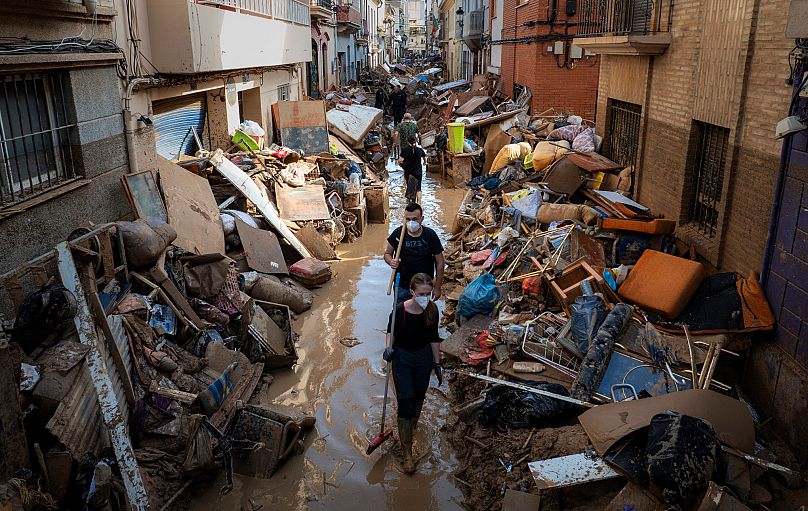Last year was the hottest year on record for Europe, with record-high annual temperatures in almost half of the continent.
The latest European State of the Climate report from the EU’s Copernicus service (C3S) shows that 45 per cent of days were much warmer than average, and 12 per cent were the warmest on record.
More than 100 scientific experts came together to demonstrate that the impacts of climate change in Europe - which is warming twice as fast as the global average - were abundantly clear in 2024.
Storms were often severe, flooding was widespread, and parts of the continent were gripped by record-breaking heatwaves.
Experts from C3S and the World Meteorological Organization (WMO) warn that “additional fraction of a degree of temperature rise matters” as it accentuates the risk to people’s lives, to economies and to the planet.
How is Europe experiencing the ‘serious impacts’ of climate change?
The 2024 report “highlights that Europe is the fastest-warming continent and is experiencing serious impacts from extreme weather and climate change,” according to WMO secretary-general Celeste Saulo.
All European regions saw a loss of ice last year as glaciers in Scandinavia and Svalbard experienced their highest rates of mass loss on record.
Wildfires in Portugal in September burned 110,000 hectares of land in a week - a quarter of Europe’s total annual burnt area for 2024. In total, blazes across the continent impact 42,000 people.
Flooding also had a dramatic and often deadly impact on communities across Europe. In September, Storm Boris affected hundreds of thousands of people with flooding, fatalities and damage in parts of Germany, Poland, Austria, Hungary, Czechia, Slovakia, Romania and Italy.

Then, at the end of October in Spain, extreme precipitation brought flooding with devastating impacts and fatalities for people in Valencia and neighbouring regions.
At least 232 people lost their lives in Valencia, with further fatalities in the provinces of Albacete, Cuenca and Malaga. Infrastructure damage and economic losses were severe, totalling around €16.5 billion.
Storms and flooding across Europe last year affected a total of 413,000 people, led to the loss of at least 335 lives and are estimated to have cost at least €18 billion in damages.
Extreme heat, too, was a problem for many in 2024. In July, southeastern Europe experienced its longest heatwave on record, lasting 13 consecutive days and affecting 55 per cent of the region.

In total, there were record-breaking numbers of days with at least ‘strong heat stress’ (66) and tropical nights (23) in southeastern Europe during the summer.
“Think 1.3°C of warming is safe? This report lays bare the pain Europe’s population is already suffering from extreme weather,” says Dr Friederike Otto, senior lecturer at the Centre for Environmental Policy and co-lead of World Weather Attribution at Imperial College London.
Europe is one of the regions with the largest projected increase in flood risk, and 1.5C of warming could result in 30,000 annual deaths in Europe each year due to extreme heat, according to Intergovernmental Panel on Climate Change (IPCC) data.
“But we’re on track to experience 3°C by 2100,” adds Otto, who wasn’t involved in the report.
“You only need to cast your mind back to the floods in Spain, the fires in Portugal, or the summer heatwaves last year to know how devastating this level of warming would be.”
Can Europe adapt to increasing risks from extreme weather?
Florence Rabier, director general of the European Centre for Medium-Range Weather Forecasts, says these widespread climate impacts highlight the “importance of building greater resilience”.
Damage to the built environment from extreme weather events is expected to increase tenfold by the end of the century due to climate change alone. Flooding has been identified as the climate risk which most urgently needs action.
Some progress is already being made. The report highlights examples of adaptation initiatives in cities across Europe, from ‘tile whipping' in the Netherlands to boosting green spaces in Paris.
Rabier adds that 51 per cent of cities now have a dedicated climate adaptation plan - up from just 26 per cent in 2018 - underscoring the value of the information the report provides.
Saulo also says that the WMO is “intensifying efforts” to strengthen early warning systems for extreme weather events and climate services to help decision-makers and society at large to be more resilient.
Continued efforts, however, are still needed to address both the current climate challenges Europe is facing and to prepare for future risks.
“We are making progress but need to go further and need to go faster, and we need to go together,” according to Saulo.
Is it time to leave fossil fuels behind?
Adaptation is just one side of the coin, however, and climate experts say the growing risk from extreme weather emphasises the need to address a significant cause of this warming.
The “major suffering and losses” seen in Europe last year make it “all the more urgent to leave fossil fuels behind as fast as possible”, says Professor Stefan Rahmstorf from the Potsdam Institute for Climate Impact Research in Germany, who wasn’t involved in the report.
“The growing renewable share of now 45 per cent of our electricity is encouraging, and it is critical for our future to resist short-sighted fossil lobby interests and to implement the European climate goals without any delay.”
The number of countries in Europe where renewables now generate more electricity than fossil fuels has nearly doubled since 2019, rising from 12 to 20. But, as the report points out, renewable power generation and electricity demand are also highly sensitive to weather conditions.
The continued use of fossil fuels in such a volatile global economy is “frankly insane”, adds Dr Otto.
“The EU can’t afford to put its climate commitments on the backburner. It needs to lead the charge and accelerate the shift to evidence-based politics, actually helping low-income people and not oligarchs.”







